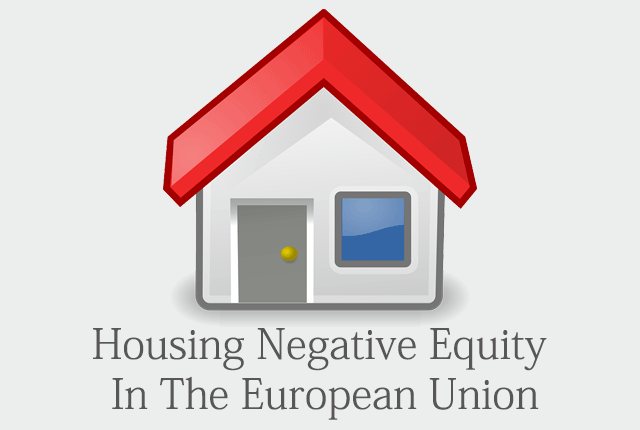‘Negative equity’ are two words that no homeowner wants to hear. They’re the kiss of death on homelife security and could throw both housing and financial situations into jeopardy. Yet, for many homeowners in the European Union, negative equity is an ongoing and genuine struggle, especially in these changing political climates.

There are various reasons for equity hits within the European Union, as we’ll consider later. For now, let’s begin by looking at what exactly negative equity is and what it means for homeowners. They don’t lie when they say that knowledge is vital, and preparing for a reality like this is your best chance of overcoming it if the worst does happen.
Understanding Negative Equity
What Is Negative Equity?
In layman’s terms, negative equity occurs when house prices drop to such a degree that the houses are worth less than the mortgages taken out on them [1].
This leaves buyers in something of a deadlock, where they’re unable to sell or remortgage the way they might otherwise. Note that a small decrease in cost does not count as negative equity. If, for example, you bought a £150,000 house with a £120,000 mortgage, your overall property price would have to drop to below £120,000 before negative equity became a problem. This leaves some wiggle room for most buyers, but it isn’t a fool-proof protection either.
If negative equity does strike, it can be a fraught and worrying time. The fact is that there are no winners in situations like this one. Homeowners feel trapped, and banks face the possibility of not getting their money back. While individual banks do put plans in place to protect against this eventuality (again, more on that later), this is far from an ideal situation.
How To Tell If You’re In Negative Equity
To make matters worse, there’s not anything in place to tell us for sure if we’re in negative equity, especially if we have no plans to sell. Even if house prices are dropping around you, then, you may falsely assume that you’re safe. In reality, this is not always the case. So, how do you tell if you’re falling foul of negative equity?
The best thing to do would first be to contact your mortgage lender. They’ll be able to tell you how much debt remains on your current mortgage plan. Remember that your house price only has to be higher than the amount you have left to pay. Even if property values have dropped lower than your initial mortgage you may still be in the clear.
Once you understand the value your house needs to meet to keep your equity clear, look at local prices or have a valuation if you’re worried. Then, you’ll know for sure and can take action if negative equity has come knocking.
What Can You Do About Negative Equity?
If you do find yourself in negative equity, it’s essential to know what you can do about it moving forward. As mentioned, this situation often leaves homebuyers in a locked-down mortgage, but you can always put some plans in place to change that.
We’ll discuss later some European banks who have begun to introduce negative equity loans which can help here. If that isn’t available to you, though, then other plans of action could include –
- Wait for house prices to rise
While it may not seem ideal, it’s worth noting that house prices fluctuate from one year to the next. As such, negative equity generally doesn’t last long other than in extreme circumstances like a financial crash. You may well find, then, that waiting negative equity out for a year or more is all it takes to get through. While it isn’t a pleasant thing to have over your head, at least you’ll still be paying towards a debt-free life during this time. - Overpay on your current mortgage
Paying off your existing mortgage altogether would be the best plan of action possible here. Sadly, few of us can afford to do that upfront. Still, agreeing to overpay your negative equity every month at a rate you can afford might work best. This will clear your debt faster and could ultimately see you buying your way out of this negative situation. Do note that most fixed-rate mortgages have early repayment charges, though these may well be worth paying where negative equity is concerned. - Rent your current property
Concerning overpayments, you might also want to consider renting your property out to work through negative equity. Many lenders will agree to this in extreme cases as it also benefits them financially. Then, you would be able to accrue money which allows you to either move or pay your way out of negative equity while you rent yourself.
Of course, understanding the negative equity basics doesn’t bring us any closer to knowing the part it plays in the European Union. Various countries across Europe, namely areas like Ireland, Spain, and Greece, have all fallen into severe negative equity periods in recent years. Fears, too, are rising that the same fate could soon hit in Britain.
This is especially worrying for homeowners as the majority of EU countries follow recourse legislature that puts the entire burden of mortgage debt on the consumer’s shoulders. Admittedly, house prices across Europe are currently thought to be on the rise, but what’s behind these negative equity issues in the first place?
Financial Crisis

In the EU and everywhere else, financial crises of various kinds are the most common contributors to negative equity. A large part of the mortgage lockdowns in the EU today, for instance, are still ripples effects left from the 2008 global financial crash. House prices plummeted as banks went into disarray.
The impact on the housing market was so severe that the Bank of England reported an astounding 1.2 million homeowners faced negative equity in the UK at the time [2]. Portugal and Spain, too, are still in the process of recovering from the impact of the financial crisis on their housing markets.
Large-scale financial crashes aren’t the only bank-based issue here, either. Ireland has been in what’s commonly referred to as a ‘negative equity era’ since a national recession in 2011. This shrank the economy by 0.2% in the first three months alone, followed by a contraction of 1.1% in the third quarter [3].
According to Louise McBride of the Irish independent, the implications of this hit mean that 230,000 homes are still in negative equity today [4]. The good news is that things do look on the up, with Ireland house prices seeing a rise of 10.2% here during 2018 compared to the EU average of 4.4% [5]. Still, Ireland is a prime example of the long-reaching implications that even natiional financial crises can bring.
Greece, too, has a housing market ruined by national debt, though of a different kind. Rather than banks creating debt, Greece’s government ran into significant financial difficulty.
The good news is that this hasn’t had the same impact on the mortgage market as can be seen from bank-based crises. The bad news is that Greece’s housing prices still saw one of the most significant hits of 32% or more during the crisis peak back in 2010. At the height of this period, one in three homeowners feared losing their houses as mortgage, and even tax payments became impossible.
At that period, around 90% of all home sales were made to people overseas, a fact which is still helping turn the market around today [6]. For locals, though, the negative equity that’s still very much in place is a harsh reminder that it isn’t only our banks we need to look out for. Any financial crash can plunge us into negative equity overnight.
Brexit
We couldn’t talk about negative equity within the European Union without also mentioning Brexit. It’s no secret that house prices are predicted to drop an average of 6% across the UK in the wake of a no-deal Brexit [7]. That could lead to significant issues of negative equity but, of course, the UK wouldn’t be in the EU at the time.
That said, Brexit in itself has still had some impact on negative equity in the EU on the whole. A look at housing markets across the Union certainly reveal a lot of uncertainty, and much of this uncertainity is leaving house buyers and lenders nervous.
A significant reason for this is that no one is currently sure of the impact a no-deal Brexit could have on both the EU and Britain itself. With many banks worried about property values in relation to macro-stabilisation policies [8], it’s entirely possible a financial hit on the European Union could ripple into individual housing markets. That threat, in itself, is evident in EU housing prices right now.
Irresponsible Lending
It’s no secret that the financial crisis was, in large part, a result of irresponsible lending by our banks. After irresponsible mortgages like 100% loan to value (LTV) during the 90s, banks across the EU found themselves in debt when consumers were left unable to pay them back.
This then led to a banking crash, which resulted in a reduction in house prices and even more wide-scale negative equity. It’s a vicious cycle, and it seems that many banks still haven’t learnt their lesson here.
The UK is a prime example in this instance. The 90s saw endless 100% LTV mortgages, and this ultimately led to a significant housing crash, followed by a tightening across the board for affordability checks.
These checks are still in place today, with banks comparing everything from income to lifestyle before agreeing to a loan. Yet, due to the ongoing struggle of first-time buyers, up to 95% LTV mortgages are creeping back into the mainstream.
Similar situations can be seen in various countries across the EU, despite European Union standards to overcome the issue. While house prices are improving in certain areas fears are arising as to whether lax lending could again lead to increased rates of negative equity.
Falling House Prices

Of course, at its very heart, negative equity in the EU and anywhere else comes down to falling house prices. As we’ve already touched on, house prices naturally fluctuate from year to year, but sudden declines that outstrip national averages are a driving cause of negative equity.
This is especially likely in EU countries that offer high LTV rates, as borrowers are pushed to their financial limits each month already. Even a small shift in house prices could therefore lead them to the negative equity spiral. As we’ll discuss, rising interest rates in this situation could also leave homeowners in some trouble.
The good news is that house prices are generally rising in even damaged housing markets across the EU right now. That said, the European Union isn’t altogether free from low-cost housing implications. According to Eurostat, Italy and Sweden experienced decreases of -0.6% and -0.9% in housing last year.
The situation has become so dire in Italy that many houses were sold at just one Euro. According to Idealista, house prices in Italy are currently 16% cheaper than the average UK prices, and even 15% less expensive than in Ireland [10].
That makes positive equity nearly impossible to come by within Italy. Meanwhile, drops in Sweden mean that they’re facing some of the highest negative equity levels in the world right now [11].
Rising Interest Rates

Mortgage interest rates also have significant impact on negative equity. The amount of interest you pay on your mortgage over its duration can increase your debt, especially in instances of fluctuation. One way around this in many European countries would be to take out a fixed-rate loan (more on that later). Still, much EU negative equity lands at the feet of high or rising interest rates.
This, or rising interest rates paired with the high LTV rates found in many EU locations, can leave homeowners at the risk of negative equity even after slight shifts in their housing markets. Sadly, uncertain markets are more at risk of the high-interest rates that can cripple homeowners already experiencing negative equity.
Thanks to mainly rising house prices across the EU right now, though, interest rates are pretty stable below 6%. Countries like Germany have even enjoyed ongoing rates of less than 3% for the last five years.
Poland comes out at the bottom with the highest listed 6% interest rate [12], and the implications of this can undoubtedly be seen in negative housing equity across the country. When you look into the issue, it seems that even the high 6% interest rate isn’t the worst interest for negative equity found here.
Many Polish homebuyers took out Swiss Franc (CHF) mortgages during the 2004-2008 boom [13]. These mortgages came complete with astounding annual interest rates of about 8.7%, making negative equity nearly inevitable.
Countries like Romania also come bottom of the list with rates of 5.85%. This, even though 96% of homes throughout the country are privately owned [14]. A glance at the Romanian housing market doesn’t seem to reveal negative equity problems as it stands. Still, high interest mixed with 95% loans popular in 2009 for helping first-time buyers leaves many Romanian homeowners on the cusp of negative equity after even small changes.
Countries with interest rates beating EU averages are also at risk given that interest rates can change at any time. And, when they do, even financially comfortable homeowners stand to struggle with meeting monthly payments.
Understanding EU Mortgages In Light Of Negative Equity

If you would like to look inside the cover click here
As we touched on in the previous point, the type of mortgage homeowners choose can either save them from negative equity or contribute towards it. As mentioned, the high-interest rates of Swiss Franc mortgages have led to wide-spread negative equity across Poland. Much of the housing crisis in Cyprus is also a result of Swiss Franc lending.
These cautionary tales are proof that residents need to think long and hard about the best mortgages for them. Many EU countries are also offering sustainable mortgage options in the wake of the financial crash. The sad reality is, though, that no mortgage is entirely free from the risk of negative equity.
Still, banks across the EU are doing what they can to cover that gap with a variety of mortgage types including –
Fixed Rate Mortgages Across The EU
Many countries in the European Union now favour fixed-rate mortgages, and they seem to be a favourite for homeowners, too. In fact, according to the Financial Conduct Authority, 90% of homeowners chose fixed-rate mortgages in 2017 across destinations like the UK [15], a rate which is sure to have risen since.
As is evident from the title, a fixed-rate mortgage is simply a loan term that secures interest rates for a set period. The duration for which loans like these are available varies across the European Union, with lenders in the UK hesitant to offer fixed rates for any longer than ten years each term.
Virgin and Yorkshire Building Society are also famously the only UK lenders to currently provide fifteen-year fixed-rates [16]. Gordon Brown did attempt to introduce longer fixed terms of 25-years during his time as prime minister, but banks that introduced such mortgages soon found limited demand for these loans. By comparison, some EU countries find it beneficial to actively encourage fixed-rate terms of twenty-five years or more.
As an example, fixed-rate periods in Denmark typically last for around thirty years. In France, too, 20-years is a standard fixed-rate period [17].
The benefit with mortgage terms like these is, of course, the fact that they can help to negate most of the negative equity risk factors. When you have a fixed-term, you’re locked into the agreement you made at the time of getting your mortgage.
That means a long fixed period largely negates the risk of changing interest rates or house prices, with your set rates remaining the same regardless of what is happening elsewhere in the market.
This can also go some way towards helping you to weather financial crashes. It’s no wonder, then, that many homeowners reach for plans like these as standard. They certainly seem to be the best option for avoiding negative equity.
That said, the benefits of fixed-rate mortgages aren’t entirely without incident of negative equity. Issues like these do, after all, lock homebuyers to a property. That need to stay put can be worsened by fixed terms. Borrowers who sign up for extended periods end up stuck in their chosen property for the duration of their term, even when house prices are plummeting around them.
Equally, early repayment charges attached to loans like these can make it even trickier to get out of negative equity. This is something countries like France are working around by getting rid of early payment charges, but is still an issue in many EU countries.
In the case of rising house prices, a fixed-rate loan could also lead to negative equity if you were paying excessive interest rates in a flourishing market.
It’s worth noting, too, that a fixed mortgage term can’t stop changing house prices from leaving you in negative equity if you sold later. Remortgaging at the end of your fixed term could also become problematic. If prices varied a lot or you did land in negative equity, you could suddenly find your monthly payments skyrocketing to unaffordable levels.
These and other reasons like them are why the UK has struggled to introduce longer fixed terms. They’re also why borrowers should consider cases of negative equity before agreeing to long contracts.
Variable Rate Mortgages Across Europe

Variable rates are probably the second most popular mortgage option. Unlike fixed rate mortgages these mortgages are based on the standard variable rates of a lender. This means that changes in everything from interest rates to house prices can impact the amount a borrower pays back. That could lead to changing payments on an annual and sometimes even monthly basis.
While many EU countries prefer and recommend fixed rate mortgages, some EU lenders also favour variable rates. Portugal and Spain, for example, have previously bolstered mortgage lending on the back of low variable interest rates.
Germany is perhaps the leading EU cheerleader for variable rates, with many borrowers preferring this level of flexibility in the face of job uncertainty and ever-changing housing markets. That said, most German lenders do cap amounts on variable rates, despite there being no law in place suggesting they do so [18].
This is because German banks understand all too well what can happen when variable rates go wrong. A sudden plummet in the housing market, for example, could see variable-rate borrowers facing soaring interest rates that they’ll never be able to pay. This is one of the most common causes for negative equity, and it’s a worry that fixed-rate mortgages do away with.
That said, as Germany has realised, some borrowers find it easier to get out of or avoid negative equity altogether on the back of variable loans. That’s because they can sell houses either in the lead-up to or during a crisis, ensuring they’re able to avoid ever-escalating costs that fixed-rate lenders are trapped with.
In large part, the suitability of loans like these across the EU depends on how long homeowners intend to remain in any given property. Household income should also play a part, with higher-earning families better able to manage the risks of variable rates.
The Rise Of Negative Mortgages In Europe
In the face of negative equity, many European Union countries are also beginning to introduce negative equity loans. Denmark is leading the way in this ground-breaking new form of lending, with their third-largest bank, Jyske Bank, now offering -0.5% mortgages [19].
These mortgages are provided on a ten-year fixed-rate term and mean that lenders pay back less than they borrowed. In other words, a homeowner buying a house for £1million would only actually pay back £995,000. . If you want to read more about it an article has been written on the subject by Emmie Martin for www.cnbc.com which you can read by clicking here.
This may seem counterintuitive, but Jyske explains that they would rather face inevitable small losses than the hit they would take in the face of negative equity.
This new way of lending provides borrowers with room for increases that won’t leave them declaring bankruptcy. It’s unusual, but it certainly makes sense for both bank and lender, and is a trend that many fellow EU countries could benefit from paying attention to.
How EU Banks And Homeowners Can Protect Themselves Against Negative Equity
Jyske Bank has developed a unique way to protect themselves from the hit of negative equity, but how do other banks and homeowners weather this reality across the European Union? For the most part, banks account for and cope with negative equity through the use of something called lender’s mortgage insurance (LMI).
As it sounds, this type of insurance provides a guarantee for a lender in the instance where they don’t receive full repayments on loans. As can be seen from financial crashes like those in Ireland, though, this is not a fool-proof plan for wide-spread defaults and issues. It also offers no protection for borrowers.
That’s where consumer’s insurance comes into play. Also known as mortgage protection insurance, accounting for policies like these in monthly payments could see homeowners avoiding negative equity altogether. These types of policies are widely available to all homeowners across the EU.
Some lenders even offer such insurance or require it before approval. As well as protecting against fluctuating house prices and interest rates, mortgage protection guarantees lenders can continue meeting payment in times of sickness or job loss. In short; this is the most rounded and vital way for homeowners to avoid EU negative equity at all stages of their life.
The Future Of Negative Equity In The European Union

If you would like to look inside the cover click here
On the cusp of Brexit and significant EU changes, many homeowners are wondering about the future of negative equity. While Britain is leaving EU protection, other countries still deserve to know what the European Union intends to do to negate negative equity moving forward in these uncertain times.
House prices may be on the rise for now, after all, but a significant change is imminent. Luckily, as can be seen from Denmark’s negative interest mortgages, banks do realise their responsibility here. As it stands, some of the most significant shifts away from negative equity in the EU come in the form of –
- Negative interest loans
We’ve already touched on negative interest loans, but they’re by far the most ground-breaking effort against negative equity in the EU right now. While the feasibility of this Danish incentive has yet to be seen, the implications are positive for both homeowners and lenders alike. We could soon see similar initiatives across the EU. - Independent lenders
Many EU borrowers (as many as 60% in the UK and Netherlands [20]) are also realising the benefits of independent lenders like brokers. This is a practice that’s already widely used in the US and involves working with independent advisors who look into the best loans for your finances, rather than those that stand to benefit a lender. This kind of independent service can both help borrowers towards more affordable loans, and ensure they’re more aware of the market on the whole. - Transparency
Transparency is another vital feature and is the one that can be seen most widely across the European Union to date. In the aftermath of irresponsible lending in the 90s and beyond, the EU has now changed its policies. All mortgage lenders today must provide customers with a European Standardised Information Sheet (ESIS). This breaks down payments and interest rates in detail. An ESIS should also look at what monthly payments would be if interest rates rose to the higher levels.
EU law also dictates a seven-day consideration period after a mortgage offer is made, with some countries providing even more extended periods under national legislation [21].
RELATED: Freelancing Can Help You Repay Housing Negative Equity
The 20 references are available on request by commenting below.















